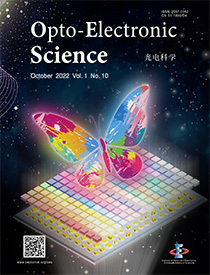2022 Vol. 1, No. 10
Cover story: Fu R, Chen KX, Li ZL, Yu SH, Zheng GX. Metasurface-based nanoprinting: principle, design and advances. Opto-Electron Sci 1, 220011 (2022).
Metasurface serves as a promising candidate for substituting conventional optical components to realize an ultra-compact nano-photonics system, taking account of its extraordinary light manipulation ability and dramatically reduced device thickness. Metasurface-based nanoprinting (meta-nanoprinting), a novel technology to realize the grayscale/color nanoprinting-image record/display, has been extensively explored all over the world. Thanks to the subwavelength unit cell and the ability of precise amplitude/spectrum modulation, meta-nanoprinting has incomparable advantages of high image resolution, delicate color exhibition, high stability and high information density. A typical meta-nanoprinting device usually has image resolution reaching 80 k dots per inch (dpi), far exceeding conventional technology such as gravure printing (typ. 5 k dpi). In particular, color meta-nanoprinting shows lots of merits compared with the conventional pigments, such as sub-diffraction spatial resolution, ultra-compact architectures, nontoxic material components and long-term durability. In this review, the authors overview the development of meta-nanoprinting, including the physics to manipulate optical amplitude and spectrum, various design strategies of meta-devices fulfilling single functionality of nanoprinting and multiple functionalities (integrating nanoprinting with holography/metalens). In addition, they introduce the applications of meta-nanoprinting, such as high-resolution image display, information encryption/concealing and multi-folded anti-counterfeiting. Due to the small volume and light weight, metasurfaces can work as anti-counterfeiting labels and can be integrated into high-end chips, watches, diamond rings and other precious commodities with small volume. Moreover, dynamically tunable nanoprinting based on electricity, ambient temperature, chemical reaction and mechanical stretching can significantly expand the functionality and applications of switchable color display, steganography, etc. It is foreseeable that with the further exploration of the design degree of freedom, a single metasurface can implement multiple control modes/multiple functionalities, promoting the development of integrated and miniaturized optical systems.

-
{{article.year}}, {{article.volume}}({{article.issue}}): {{article.fpage | processPage:article.lpage:6}}. doi: {{article.doi}}{{article.articleStateNameEn}}, Published online {{article.preferredDate | date:'dd MMMM yyyy'}}, doi: {{article.doi}}{{article.articleStateNameEn}}, Accepted Date {{article.acceptedDate | date:'dd MMMM yyyy'}}CSTR: {{article.cstr}}
-
{{article.year}}, {{article.volume}}({{article.issue}}): {{article.fpage | processPage:article.lpage:6}}. doi: {{article.doi}}{{article.articleStateNameEn}}, Published online {{article.preferredDate | date:'dd MMMM yyyy'}}, doi: {{article.doi}}{{article.articleStateNameEn}}, Accepted Date {{article.acceptedDate | date:'dd MMMM yyyy'}}CSTR: {{article.cstr}}

 E-mail Alert
E-mail Alert RSS
RSS


